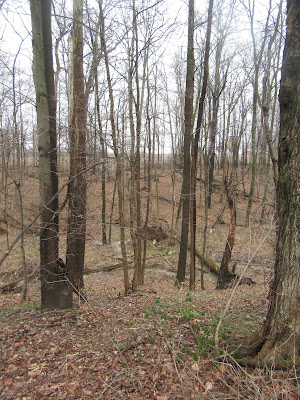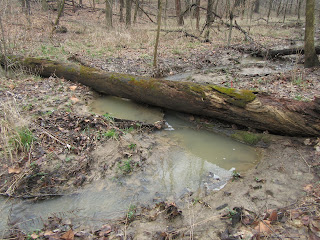Carving Out the Old
March 28, 2018
More heavy rain (on top of
snow melt) was constantly carving Cottonwood Pond and the surrounding
area into new configurations. The whole area was either puddled or
extremely soggy.
Cottonwood Pond, the Creek, and the Soggy Spot to the right
The Creek water, as brown
as watered-down chocolate, was running rapidly over obstacles, making
braided patterns in stretches between.
The Creek below Cottonwood Pond, going under the Barkless Log
The Creek immediately downstream from Cottonwood Pond
It looked like Crawdads
had taken the opportunity of a few calm days to re-carve tunnels,
only to have the newly-formed chimneys washed away again by the
raging Creek waters.
We had previous heavy
rains with their effects on the surroundings, but this one had
produced some significant changes to Cottonwood Pond. Was this a
tipping point, reached after cumulative effects?
#1
The Creek had never before
had any direct effect on Cottonwood Pond and its close environs.
Instead, excess water had always flowed into the Creek (directly or
indirectly) – not the other way around. One example is the overflow
of the main pond corner, via the Seep, into the Creek.
Cottonwood Pond (top), the Seep (middle) - dumping into the Creek (bottom)
The disintegrating Bark Ledge, where the Seep enters the Creek by the Very Rotten Log
As seen from Cottonwood Pond - Seep channels flowing to the Creek
(and Silas resting on the Very Rotten Log)
During a deluge, whenever
the Creek would flow fast and furiously it would tend to overflow its
regular banks, sometimes carving new channels.
But, on March 28 something
new was happening – the Creek was finding a way to add its waters
to Cottonwood Pond, tumbling over its eastern banks and cutting
across a flat area to the Inlet, then draining into the main pond.
Where the Creek had overflowed its eastern bank (upper right) and went in an eastward direction toward the Inlet
Flow paths from Creek toward Inlet, as seen from the east/southeast
New flow path from Creek, headed toward the Inlet (left)
The Inlet, on the main pond side
Ordinarily, water entered
Cottonwood Pond and “little pond” via overflow from the Swampy
Spot (which was fed by drainage down slopes into Temporary Creek #1)
and directly by precipitation. Sediment always washed in from that
floodplain. It was still doing so at this point, but with the
addition of Creek water from the south.
Temporary Creek #1, extremely full
Temporary Creek #1 flowing into the Swampy Spot
Flow from Swampy Spot, headed toward the Inlet
Outside of Inlet
What would it mean for
Cottonwood Pond, that it would sometimes be taking in water from the
Creek? The Creek starts somewhere beyond our property to the
east/southeast [I hope to determine its beginnings in the future],
flows under the road via a tunnel, then winds its way through the
bottom land of our woods, picking up sediment and other things along
the way. This normally would travel on down through the rest of our
bottom land, eventually draining into the small River du Chien
(colloquially “River Dushee”) well beyond our property.
With this new change, the
Creek would be sharing some of its pick-ups with Cottonwood Pond. How
would this affect the water and life of Cottonwood Pond?
#2
The raging waters, not
only through the Creek but also across spots of land, had pushed
items well beyond their previous locations in a very short time. The
appearance of these items testified to the power and volume of the
water. I had previously seen the beer can that traveled all the way
from the roadside (where some hapless driver or passenger had tossed
it out.) The water had dumped it onto the flat area between
Cottonwood Pond and the Creek.
On March 28 other things
appeared:
Near "little pond"
What has appeared in the Creek, on the downstream side of the Barkless Log?
A child's wagon wheel?
Natural item - a chunk of root from the Root Ball, which had fallen into the main pond, has been washed into the flat area beyond the pond.
Normally I would pick up
any trash I find and dispose of it. But, I will leave these items
just to see how far they move, and how fast, through the Cottonwood
Pond environs, and will pick them up before they travel further
downstream.
#3
More large Cottonwood root
sections were exposed on the Root Ball, looking like bleached bones
appearing through an archaeological dig area. Rain pounding on the
Root Ball and washing away soil also exposed a delicate cascade of
fine roots.
Root chunks that had fallen from the Root Ball some time ago, covered by mud from the Root Ball and sinking further into the pond water
#4
The Root Ball had been so
severely eroded on the northern edge that it resembled a monster's
profile.
From the "little pond" side
From the main pond side
#5
Water had washed so
vociferously over the Isthmus that roots were being exposed there,
too, probably originating from the Two-Trunk White Ash.
#6
With Temporary Creek #1
and the Swampy Spot filling up so much the flow going under the Trunk
(toward “little pond” and Temporary Creek #2) was more pronounced
than ever before. A “dam” of debris had been building between
“little pond” and Temporary Creek #2, also.
From the Swampy Spot
To the Trunk and under it
Coming under the Trunk and pooling before flowing into "little pond"
Water flowing into "little pond" from under the Trunk
(overflow from "little pond" toward the right, to Temporary Creek #2)
Pooled area between Trunk and "little pond"
Overflow from "little pond" (center) toward Temporary Creek #2 (foreground)
Debris "dam" between "little pond" and Temporary Creek #2
Other changes were taking
place at Cottonwood Pond, such as more bark falling from the
Cottonwood Trunk, exposing more rootlets, fungi mycelia and rotting
wood to the elements.
And with Spring
progressing a little further, more plants were springing to life.
Appendaged Waterleaf plants on the slope - growing bigger!
Looking down the slope toward the Creek and Cottonwood Pond - some spots of green becoming obvious
Next to the main pond
Violet leaves on the Mud Pile
In the Swampy Spot
Unfortunately, an Asian Bush Honeysuckle near Cottonwood Pond has re-sprouted - I had cut the shrub last year. They are easy to spot - the first shrubs to leaf out, before any of the native shrubs.
Harbinger-of-Spring
Spring Beauty
Virginia Bluebells in bud
Moss on the Barkless Log
Moss sporophylls on the Barkless Log, above the Creek
Another type of moss
Moss and lichen on an old log
A foliose type of lichen
More variety of lichen
Smooth-footed Powderhorn lichen
Leafy liverwort
In the woodland, a Bitternut begins to open near a mat of moss and some Cut-leaf Toothwort leaves
The month of April should
see so much more. With the exception of pretty white snowy scenes, the landscape at Cottonwood Pond and the woodland in general has been a combination of grays and brown. But, the greening mosses and lichens as well as little plants appearing will soon change the color of the scene. Very soon, some trees will begin to open tiny new leaves, lending a green mist to the woodland.
And, it is time to begin taking samples of water from Cottonwood Pond, to see if tiny animal life forms have been appearing, also.
On the Mud Pile

































































